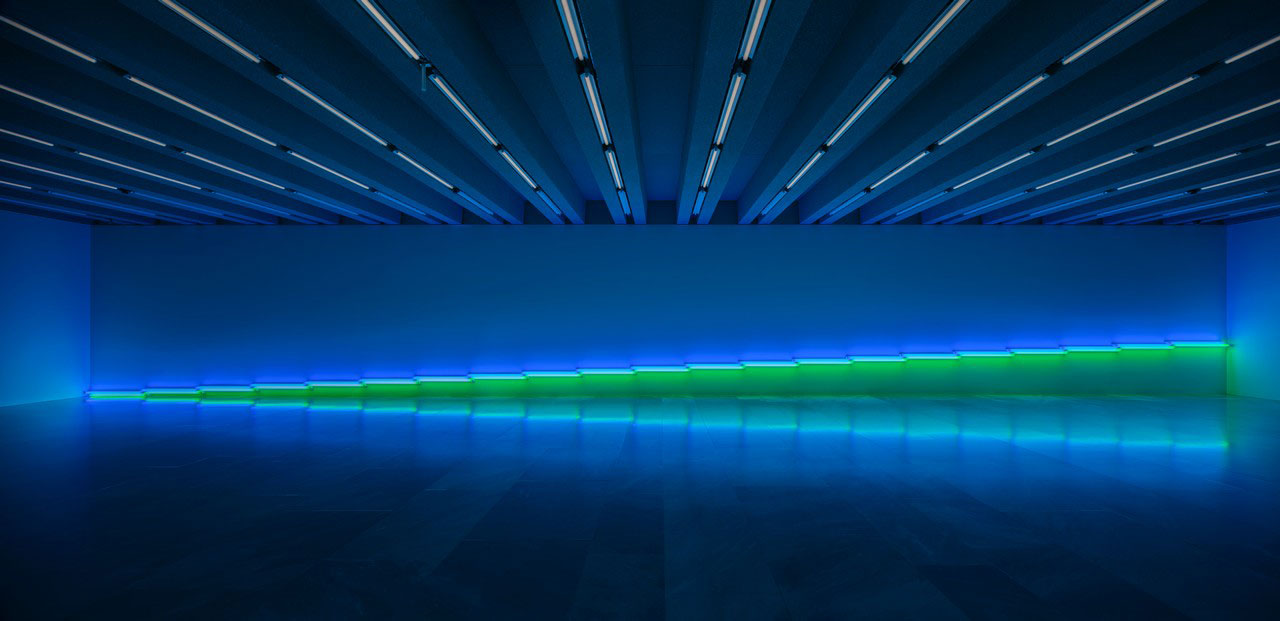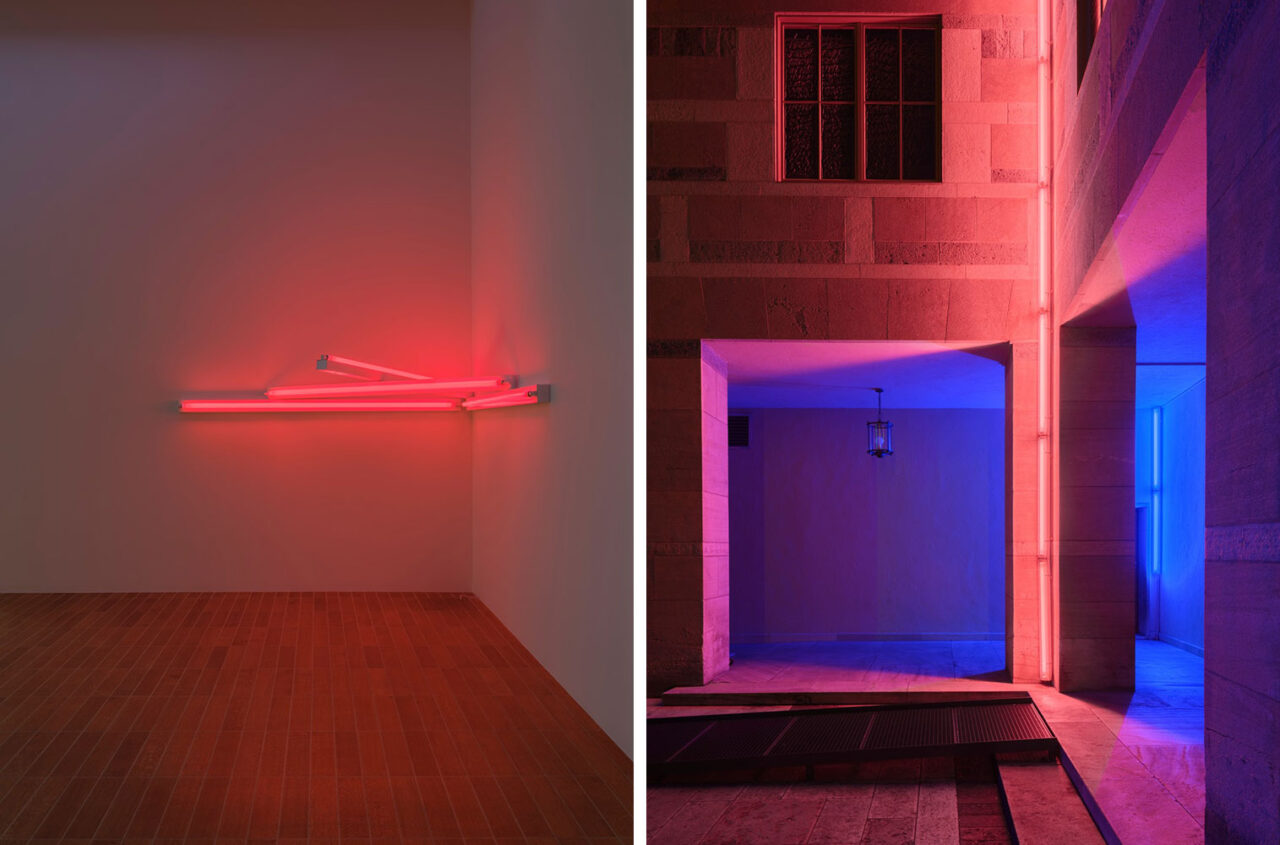PRESENTATION: Dan Flavin-Dedications in Lights
 Dan Flavin was a pioneer of Minimal Art. He rose to fame in the 1960s with his work with industrially manufactured fluorescent tubes, inventing a new art form and securing his place in art history. In 1963 Dan Flavin mounted a single, industrial fluorescent light tube at a 45-degree angle to the wall of his studio declaring it art; the act was radical, and it still is. Indeed, it was owing to this action that standard commercial products would be introduced into art.
Dan Flavin was a pioneer of Minimal Art. He rose to fame in the 1960s with his work with industrially manufactured fluorescent tubes, inventing a new art form and securing his place in art history. In 1963 Dan Flavin mounted a single, industrial fluorescent light tube at a 45-degree angle to the wall of his studio declaring it art; the act was radical, and it still is. Indeed, it was owing to this action that standard commercial products would be introduced into art.
By Efi Michalarou
Photo: Kunstmuseum Basel Archive

Under the title “Dedications in Lights” the Kunstmuseum Basel dedicates an extensive special exhibition to Dan Flavin, who rose to fame in the early 1960s with his work with industrially manufactured fluorescent tubes. The exhibition brings together thirty-five light installations, twenty-one works on paper, two early paintings by Flavin that are rarely displayed, and a selection from the works by Urs Graf that Flavin chose for his presentation at the Kunstmuseum Basel in 1975, some of which have never been on view in Switzerland, the exhibition presents a thematically as well as chronologically organized survey of Flavin’s singular oeuvre, with a focus on works he dedicated to individuals or events. It is the artist’s first major show in Switzerland in twelve years. Dan Flavin made history by creating a new art form. His works made of light extricated color from the context of painting and transposed it into three-dimensional space. Using commercially available light fixtures, he defied conventional ideas about authorship and processes of art production: His decision to make art out of a mundane utilitarian object, radical even by today’s standards, caused a stir among his contemporaries. The earliest exhibitions of Flavin’s fluorescent lamps in New York left artists and critics thrilled by his purism, the fascination of his “gaseous images” (a term the artist himself liked to use), and the physical immediacy of their glowing presence. Flavin’s fluorescent tubes bring to mind factory halls, fast-food restaurants, and parking lots. The artist leveraged this effect and the limited palette of colors (blue, green, red, pink, yellow, ultraviolet, and four different shades of white) predetermined by the technology. In the course of his career, single tubes and simple geometric arrangement s evolved into complex architectonic works and elaborate multipart series. Flavin insistently rejected the designation “sculpture” or “painting” for his works, which he preferred to characterize as “situations.” In his writings and other statements, he moreover emphasized the factual quality of his art. In the catalogue accompanying his first major work for an institution, installed at the Van Abbemuseum in 1966, he wrote: “Electric light is just another instrument. I have no desire to contrive fantasies mediumistically or sociologically over it or beyond it. (…) I do whatever I can whenever I can with whatever I have wherever I am”. Flavin’s uncompromising self-limitation to working with a single industrially manufactured object and the serial quality of his creations arguably aligns his oeuvre with Minimal Art. Besides Flavin, Carl Andre, Donald Judd, Sol LeWitt, and Robert Morris are widely regarded as the movement’s leading protagonists, though each of them more or less firmly repudiated the label. The artist himself negated the symbolic tenor of his work and disregarded its sometimes sublime effect. Yet as numerous art critics have pointed out, Flavin’s work can nonetheless be connected to Christian and metaphysical motifs, suggesting allusions to spaces of prayer and meditation illuminated by votive candles. What is striking, though, is that Flavin habitually dedicated his works throughout his career, associating them, often in sentimental and solemn fashion, with individuals or events. Many of the fluorescent light installations he produced from 1963 on are dedicated to artist friends like Jasper Johns, Sol LeWitt, and Donald Judd. Modernists like Henri Matisse, Vladimir Tatlin, and Otto Freundlich likewise make appearances in Flavin’s titles. These dedications stand in deliberate contrast with the anonymity of the material. By integrating them into his titles, Flavin anchored the non-narrative and impersonal works in a specific aesthetic, political, and social context. The constitutive role of the titles is also salient when Flavin makes reference to political events. Some works commemorate wartime atrocities and must be read in connection with Flavin’s outspoken opposition to the Vietnam War: for instance, “monument 4 for those who have been killed in ambush (to P.K. who reminded me about death) “, which he showed in the exhibition “Primary Structures. Younger American and British Sculptors” at the Jewish Museum, New York, in 1966, one of the first institutional presentations of the rising minimalist movement’s output. No less remarkable are the pieces that Flavin dedicated to people he worked with. A prominent example in the exhibition is “untitled (to you, Heiner, with admiration and affection)”, dedicated to the legendary German art dealer Heiner Friedrich. After immigrating to the U.S., Friedrich, in 1974, founded the influential Dia Art Foundation, Flavin’s site-specific work “untitled (in memory of Urs Graf)” has been permanently installed in the Kunstmuseum Basel | Hauptbau’s interior courtyard since 1975. By now we cannot even imagine the courtyard without the extraordinarily atmospheric play of pink, yellow, green, and blue light. In the late 1970s, however, the museum’s trustees still disagreed over whether the work should remain in place. A final decision was only made when the Dia Art Foundation gifted it to the Kunstmuseum, whose leaders even then preferred to keep it switched off. The episode exemplarily illustrates that it took insistent advocacy to bring about what was a radical transformation of habits of seeing and shift of opinion. Documents from the institutions’ archives that shed light on this process are on view in the exhibition.
Photo: Dan Flavin, untitled (to my dear bitch, Airily) 2, 1984, blue and green fluorescent light, 244 x 20 x 61 cm, © Stephen Flavin / 2024, ProLitteris, Zurich, Creditline: The Dan Flavin Estate, Courtesy David Zwirner, Photo Credit: Florian Holzherr
Info: Curators: Josef Helfenstein, Olga Osadtschy, Elena Degen, Kunstmuseum Basel, St. Alban-Graben 8, Basel, Switzerland, Duration: 2/3-18/8/2024, Days & Hours: Tues; Thu–Sun 10:00-18:00, Wed 10:00-20:00, https://kunstmuseumbasel.ch/

Right: Dan Flavin, Untitled. In memory of Urs Graf,Production time: 1972 concept / 1975 version, Installation with pink, yellow, green and blue fluorescent light in the four corners of the front courtyard of the Kunstmuseum (11 units each) and in the four corners of the arcade arcade (2 units each), Length: per unit 120 cm 40 Watt, 48″ T12 BIPIN (true red, true green, true yellow, true blue); Diameter: 3. 54 cm per unit, Photograph: Stephen Flavin/Getty Images, Creditline: Kunstmuseum Basel, gift of the Dia Art Foundation, New York, Photo Credit: Florian Holzherr




